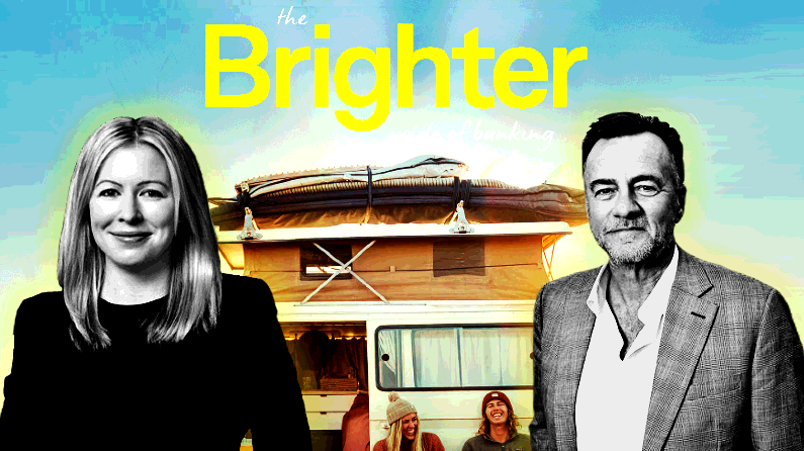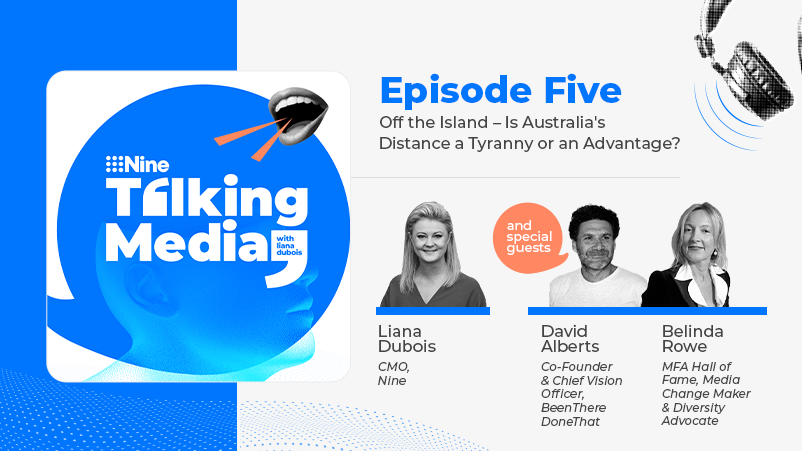Commbank CMO Jo Boundy backs owned media assets, publishing venture to 8 million customers; launches print magazine - with advertisers - in first wave of new ‘content ecosystem’

Commbank's Jo Boundy and News Corp's Mike Connaghan: "We see content as part of that broader awareness, consideration, engagement activity...it's very much part of long-term brand building," says Boundy.
ANZ Bank triggered a flurry of fret and fury among newsmedia and business journalists nine years ago when it poached the AFR’s veteran banking editor Andrew Cornell to lead an in-house B2B publishing venture called Blue Notes. Commonwealth Bank just replicated the move on a grander scale with News Corp’s Commercial Content unit. It's plotting a broader consumer and small business publishing venture and has poached Sydney Morning Herald senior economics writer Jessica Irvine, installing her inside the bank’s marketing unit. More hires from traditional media groups are likely. Commbank CMO Jo Boundy says the ramped-up publishing venture is part of an increased brand investment strategy versus performance marketing and sales activation.
We definitely adopt the principle that we should be spending more money on brand than sales activation. We very much see content as part of that broader awareness, consideration, engagement…part of that long term brand building marketing activity.
Commbank the media company
Commbank CMO Jo Boundy says “the whole media and marketing landscape is changing quite rapidly” and the bank is looking to fill a gap in financial content for consumers and SMEs that is not being served currently by media groups.
Boundy’s publishing strategy puts a new twist on the raging broader debate in the marketing sector around the current economic conditions and the tension on allocating marketing budgets to capture short term demand via sales activation and performance marketing tactics and longer-term investment in building brand and customer loyalty.
“Content is one of the things that we're looking at evolving as part of our broader brand and marketing strategy,” Boundy told Mi3. “ The genesis of this, when we step back and look at the whole media and marketing landscape at the moment, is it's changing quite rapidly. Consumer behaviour is changing. The environment in which people participate is changing. We're seeing consolidation of media partners, consolidation of platforms. And one of the things that we're very aware of is that we need to make sure that our marketing strategies - and I'd say this goes for all brands – are responding to that changing media landscape and digital landscape. One way that we're doing that is through a new content ecosystem.”
Sell audiences, self-fund, reinvest in marketing
It's an ambitious program which is still rolling out but Boundy is part of a wave of blue chip marketers who see content as part of a more sophisticated marketing plan – and they’ve figured out it can underwrite part, or in some cases all – of a company’s marketing budget.
Owned media audit and advisory firm, Sonder, estimates the media channels and audiences (customers) of enterprise-size companies is collectively worth $120 bn – six times the current media ad market – if they are valued on a like-for-like basis in paid advertising and audience reach of a commercial publisher. Sonder estimates the average value of media assets owned by a financial services company is $117 million – for supermarkets it’s $382 million. Some telcos, airlines, utilities and retailers advanced in leveraging their owned media assets are underwriting up to 40 per cent of annual marketing budgets by selling their audiences and media channels to other advertisers, suppliers and trade partners.
Boundy has similar ambitions for the bank. In the launch edition of its print magazine, Brighter, which has just hit 700 branches, Motorolla, Logitech, Norton and telco reseller More have taken paid ads in the book.
Boundy says Commbank has undertaken an audit of its media assets and valuation with Sonder but stopped short of tabling a figure. “I'm not going to disclose that but I definitely think they're compelling,” she says. “If you think about the size, scale and reach of a brand like CBA and the engagement we have with our customers, there's definitely an opportunity for us to use those channels to better communicate with our customers. Brighter includes some partner advertising and that's actually helping us offset the cost of the content generation. It's a way of using your own channels to extract greater value. We’re very much looking at our own channels and how we better leverage those owned channels and if you’re doing that you want to make sure you've got great content. We're actually thinking quite differently about the commercials and how it can generate revenue and therefore we can reinvest that revenue into our marketing activity.”
Content builds brand
Boundy sees Commbank’s publishing push as part of the bank’s investment in brand and customer loyalty building with ownership of the media unit sitting within the brand and campaigns team.
“We definitely adopt the principle that we should be spending more money on brand than sales activation,” she said. “And we spend a lot of time getting that balance right, the mix right. We very much see content as part of that broader awareness, consideration, engagement activity. It's going to be led out of our brand and campaigns team and so it's very much part of that long term brand building marketing activity.”
Content, she says, works “all the way through the [marketing] funnel” from awareness and consideration at the top to a customer or product conversion at the bottom.
“I do think upper and mid is content is so important in actually building a relationship.
But because we've we can create this content and we can chunk it down, you can imagine that some of the shorter form content can actually be used at that point of purchase.”
Financial services content gap
So where does Boundy see the gap in content that is not being served currently in the market?
When you think about financial services or content related to money, let's be honest, there's not a lot of it and often what exists is generally written for a business audience or quite niche. It's really not representative of all of Australia so we got to this point where we very much see ourselves as the bank for all Australians and money, financial wellbeing and financial content is relevant to all Australians. There's a bit of a gap there where we can provide compelling, engaging, really easily accessible, helpful, useful content for people to basically have better understanding about their own finances and help their money, help them manage their day to day finances. That's the crux of it.”
Boundy was coy on more detail but following the launch of the printed magazine this month, podcasts, video and web financial and lifestyle content are next in the rollout. But a print magazine?
“It's interesting, isn't it? Because a lot of people said early on, why a magazine? When you explain customers want this content, we know that they're searching and seeking high quality, easily engageable lifestyle content that helps them manage their finances, and you can start with a printed version of the magazine in long form and then you can actually take that long form and then that becomes the foundation for so many other different channels and mediums that you can push this information out on, they quickly get it.”
Commbank struck a deal with News Corp’s Commercial content unit which houses specialist content marketing agencies including Medium Rare, Storyation, Suddenly and Visual Domain. Medium Rare has landed the Commbank contract – it also produces and sells ads for Qantas magazine, where Boundy was prior to Commbank – and Coles, Bunnings and Chemist Warehouse.
News Corp - $150m business
News Corp’s Commercial Content arm generates about $150m in revenues as a hybrid outsourced publishing partner for larger enterprises and Managing Director Mike Connaghan, former CEO of WPP AUNZ when it was a listed Australian firm, says brands moving into content and owned media assets was not new but was getting renewed corporate focus.
“There's an insatiable appetite out there for content from the consumer,” he told Mi3. “It's everywhere. And smart brand are using their own channels to serve up that content to those consumers. Consumers expectations are basically driving the demand. It's really delivering an emotional ROI for brands because it's helping people through their lives, through their purchase decisions. It’s the how-to, the cost of living stuff for Commbank whereas for Coles it's around recipes and food inspiration and cost of living. For Bunnings, it's a how-to education channel.
“The ultimate example is it's not just about magazines, obviously, it's digital, it's video, it's social, it’s podcasts. We can basically help them monetise that to the point where it's a zero sum game, or even a profit.”
Cannabilsing media?
But does this new momentum from brand-owned media assets and content cannibalise News Corp’s own publishing business, competing for the same audiences and their attention and time?
Connaghan is careful: “It can be an addition to it but brands are going to become publishers in their own right anyway. It's not something new. We've been doing it in partnership with clients for many, many years. It goes right back to the old custom publishing days. But things have evolved and we are now in much broader and deeper conversations with clients because it is not their sweet spot to be producing the content. So we believe, obviously, that we're sort of born in the newsroom, we're the storytellers. We know Australians better than anybody else. We know how to sell media, we know how to set media up. And so for a client to come to someone like us to get the content done and then if they need for us to help them monetise it, it's a bit of a win win.”
Commbank guns for TV, video next
For Boundy, there’s much more to come.
“So we're starting with print but it'll be across print, digital, audio and video,” she says. “And a lot of it is directly to our own customers and in our own environment. But then we're also amplifying it across paid channels as well. So not only talking to our customers but also non-customers and then looking at how we can amplify this content to make sure that we're driving further reach and engagement. We're also thinking quite differently about how we engage with TV and video. There's a lot of movement happening in that space, as you know, with shifts in consumer behaviour. And we're thinking about how we can better use those channels and do more integration, bring to life our brand more through TV and video.”



